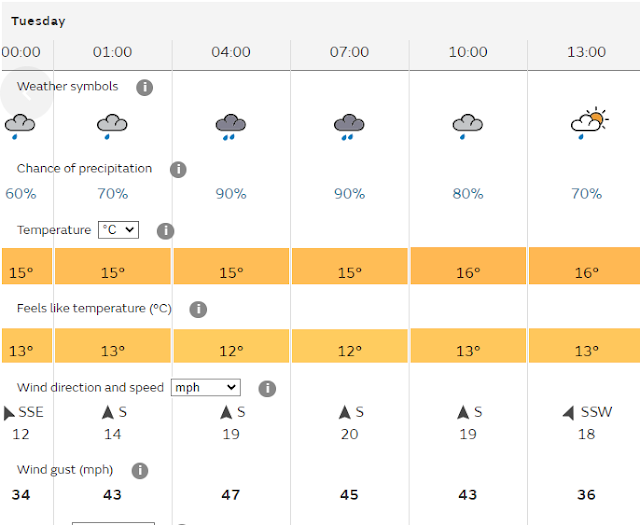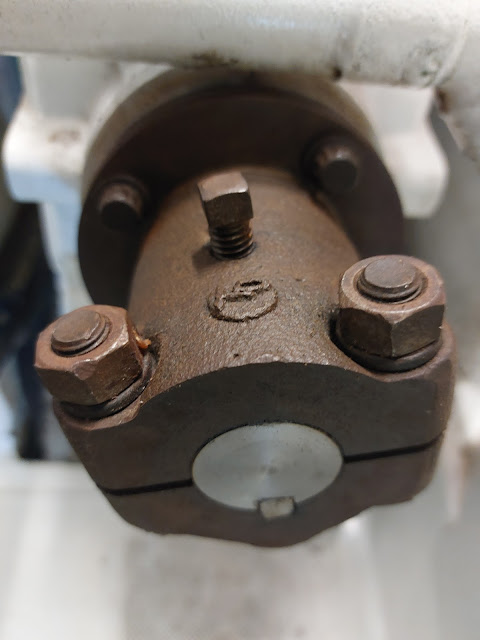Well, it seems that miracles can happen. After 18 days of Force 6 or higher winds, the local forecast turned into this:
Somehow not having strong wind warnings in August doesn't seem too much like a miracle but after the unending grim weather that had run through the whole month (bar one day!) it was worth celebrating.
As the forecast for the Irish sea was OK we just had to move. Because things had been so unsettled, we decided to head direct to South Wales, abandon the idea of stop-offs and take advantage of the two day weather window that all the different sources said would be coming up. It would be a bit splashy leaving Troon and getting into the Irish sea thanks to the F5 and earlier stronger stuff. Then it should be OK for the long run down to St David's, where you turn to the east to head up to Milford Haven. That last bit would be bumpy as a F5 easterly was coming. Just at the wrong time.
Planning a Troon to Milford trip is not simple at our cruising speed. You don't really want to fight the strong current around the Mull of Galloway or St David's head and then up to Milford. However, our speed means you have to do it for one of them pretty much! We opted to fight things at the Welsh end as having an east going tide would lessen the wave heights dragged up by the forecast winds there. Things get very messy in that area, lots of depth changes confusing and creating waves too and so anything we can do to make it a better end to the trip, was good.
So, we headed off early evening, threw up some spray and then got into the shelter of Ireland and settled in for a gentler overnight run south in the dark. The FLIR just showed us lots of waves and a few seabirds to keep us on our toes:
It still amazes us how good the images are at night - naturally newer units are even better but this version will do us nicely thanks. Keeping awake on watch at night isn't too hard. You have three screens to watch (we set them up as FLIR image, plotter and radar) and a gentle glow is created in the pilothouse:
Using the satellite TV dish we can either listen to the radio or watch some TV - mind you the TV offerings at 2am are less than exciting. We do a pretty informal watch system. When one of us wakes up and feels fit, we take over. At changeovers, the captain gets to check the main engine and pump some more fuel from the storage tanks into the day tank that feeds the engine. That way it is already filtered before it goes through the two other filters en route to the engine. We like to keep the big Lugger running happily on clean diesel.
We had good conditions although the next morning we heard on the radio, Belfast Vessel Traffic Service calling a freight ship and telling them to stay outside their area until the visibility improved and that the pilots would not commit to a time to take the ship into Belfast. Keith (the man with the ultra cute Jack Russell dog you've seen on here before) reported that you could not see from one pontoon to the next in nearby Bangor marina. We were fine though.
There are some pretty deep areas that we pass through and a couple of times the depth sounder just gave up when we were in over 210 metres of water. It woke up again:
when we re were "only" in 194 metres of the salty stuff. To be more precise it was probably 197 as we display the depth below our keel less a little bit for safety, not the true depth of water.
Here is the full route we took, according to MarineTraffic:
During the run down the middle of the Irish sea you amuse yourself with wildlife spotting, commercial ship spotting, radio and TV or just enjoying the ride. And we did - sunny and calm enough to go and have a shower so you feel more human as day 2 of the trip unfolds.
There was one strange move by an overtaking commercial guy. He had been approaching us at a nice angle from astern and was going to pass astern of us with plenty of clearance heading to the east of our track:
The CPA - closest point of approach - shown was over 500 metres so all good. Then he passed astern of us and immediately turned towards us, running parallel and then back towards the west in front of us:
Why the officer on watch didn't just alter course to the west earlier and head down the other side of us rather than doing the "loop" around is a mystery. Still, it was lovely weather and all was well:
We had one hitchhiker with us for a while:
who might just have been having a rest. The crew had a more stressful time during her watch when we passed through a gaggle of fishing boats - this time, amazingly, they all appeared to have their AIS equipment turned on so you get to see them like this:
There is a huge firing range in Cardigan bay and we would be transiting the outskirts of it in the early hours of the following day. Luckily:
and we settled down enjoying the sun setting across the water:
Our second night at sea was quiet - relatively calm, not too much trouble with shipping and all the ferries to and from Ireland were well clear of us. If you look at the last part of the route:
you can see where we turn around St Davids towards Milford. Well, this area was payback time. Although seeing the sun come up through the window in the pilothouse over the rocks off St Davids was nice:
it was getting breezier and we were pushing into a strong tide as expected:
2.3 knots speed over the ground does feel very slow.... However, although we were throwing up some spray, it did mean that the sea state was way better than it would have been with a favourable tide. Passing Skomer and the now puffin free island (shame) we were happy to turn into the shelter of Milford Haven and take advice from a local yachtsman we know (you've seen pictures of their yacht before if you are mad enough to read this stuff regularly) on the best anchorages in an easterly wind. After around 38.5 hours underway, we dropped anchor in Kilroom Bay and relaxed. After a clean up for the humans, we had a very lazy afternoon to catch up on some sleep. The crew seemed rather reluctant to say hello though:
The anchorage had two yachts in it, hardly crammed:
:
with nice rocky cliffs to admire, containing some great colour schemes. Looking the other way, you get one of the old fortifications:
this one being Stack rock. It is worth reading about the history of the fort in this Wikipedia link .
Overall, our trip was pretty much as per the forecasts, splashy at both ends but a nice calm run down the Irish sea for the bulk of the time. We ended up with a very salty boat but as that was all, we cannot complain. A nice calm sheltered anchorage and a "happy to be nearly back to our second home" feeling.
















.JPG)
.JPG)

























.jpeg)


.JPG)
.JPG)
.JPG)

